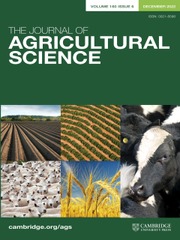No CrossRef data available.
Article contents
Evaluating the accuracy–labour trade-off between alternative grassland monitoring methods by rising plate meters
Published online by Cambridge University Press: 25 September 2025
Abstract
Production efficiency of pasture-based livestock production systems is primarily driven by the level of pasture utilisation and, as such, regular monitoring of herbage mass (HM) provides essential information to assist on-farm decision making. Unfortunately, this practice is seldom carried out on commercial farms, likely due to the time commitment required across the entire grass growing season. Recent studies have shown, however, that even moderately inaccurate HM data can improve the system-side profitability compared to enterprises with no data, warranting further investigations into the trade-off between the accuracy and cost associated with HM measurements. Using a weekly multi-paddock dataset from the North Wyke Farm Platform research site in Devon, UK, this study evaluated the technical validity and labour-saving potential of a simplified ‘pasture walk’ protocol for rising plate meters, under which only data along the diagonal transect — rather than the industry-standard W-shaped pathways — of the paddock are collected. Across 234 temporal-paddock combinations, the mean absolute difference in HM estimates between diagonal and W-transects was 106 kg DM/ha, a scale far too small to alter sward or animal management. The presented statistical analysis, together with a supplementary spatial simulation experiment, supported the generality of the findings across the full grass growing season. With a 51.2% reduction in labour time (1.2 min/ha rather than 2.5 min/ha) across paddocks of various sizes and shapes, the proposed method is likely to facilitate uptake of evidence-based grazing management amongst farmers who currently do not quantify HM at all.
Information
- Type
- Crops and Soils Research Paper
- Information
- Copyright
- The Author(s), 2025. Published by Cambridge University Press

